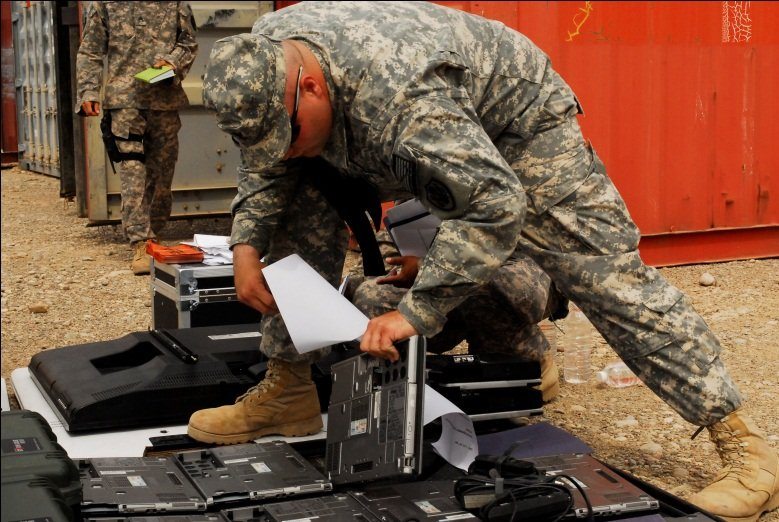As U.S. troops prepare to transition out of Iraq by the end of the year, leaders have to consider the daunting task turning in millions of dollars in equipment while reducing operations.
In the past, as deployed units rotated back to the U.S., replacement units would maintain accountability for all of the permanent equipment left behind, but for Soldiers of 1st Advise and Assist Task Force, 1st Infantry Division, the task is more challenging because they are scheduled to be one of the last units in Iraq.
As a way of being prepared when it’s time to leave, “Task Force Devil” Soldiers began turning in unserviceable property at Contingency Operating Site Warrior, April 26, 2011, through the Defense Reutilization and Marketing Office.
DRMO, a Department of Defense organization, is responsible for taking equipment a unit cannot use anymore and either re-assigning it to other Army units, selling it, or scrapping it.
“Today is a proof of principle aimed to relieve company commanders of accountability and responsibility of items needed to be turned in to DRMO,” said Col. Alvin Burguess, commander, Direct Support Team-Iraq, Defense Logistics Agency.
Burguess said he’s responsible for disposition services, meaning he oversees equipment turn-ins.
“They take everything we can’t use anymore,” said Maj. Christopher Rozhon, brigade logistic support team chief for 1st Advise and Assist Task Force.
If computers are repairable, the first thing DRMO would do is offer them to other Army units who need them, Rozhon explained. This method allows the Army to draw out the use of equipment and fill supply gaps.
“If these computers are a surplus within the Army, the next step would be to sell them in order to recover some money for the taxpayers. Lastly, if we can’t do anything else with it, we scrap it,” continued Rozhon. “If an item is at the end of its life cycle and the unit doesn’t need it anymore, or if it’s at the end of its usage as far as if the Army is concerned, we turn it in to get as much value from it as we can.”
While units must normally travel to DRMO, Rozhon said the April 26 turn-in stood out because it was the first time DRMO personnel went out to a unit to recover property.
If the DRMO personnel did not fly to COS Warrior, the equipment would then have to be shipped to their headquarters in Bagdad, he explained.
“For each property book, everyone would have to send a representative to turn in property at that location or conduct coordination to get equipment turned in and make sure it’s properly received,” explained Maj. Joel Gleason, logistics officer for the task force. “Here, they can bring a small team forward and allow all the people to turn in at this site.”
If a mistake occurs in the normal system of mailing gear to DRMO, paperwork and shipping the items back and forth creates delays for getting equipment turned in, whereas if the DRMO personnel on site say it’s a quick fix, the units have all the assets here to fix it, Rozhon explained.
“We get the paperwork, it goes and it’s one transaction, one trip,” he said.
Bringing DRMO assets to the unit saves time, personnel and money and alleviates many of the problems redeploying units face, he added.
Conducting a test-run helps identify friction points and if it works, the units will see if there is a valid need to change the system, said Col. Steve Cook, who serves as logistics officer for U.S. Division-North, 4th Infantry Division.
Gleason said other units will be able to have DRMO occasionally come to their location to allow them to turn-in excess property. That means the use of fewer resources to draw down in Iraq.










